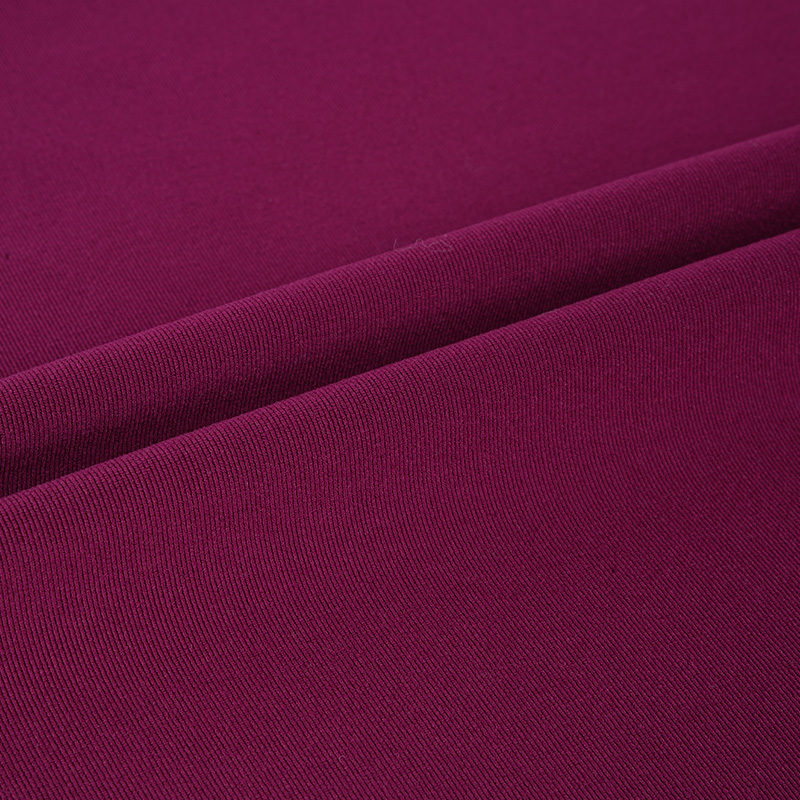We are located in Haining City, Zhejiang Province, one of China's famous knitting industrial Bases.
Activewear fabrics are designed with specific features to handle long-term wear and tear, especially in high-abrasion areas such as knees, elbows, and other parts of the body that experience repeated friction during physical activity.
1. Fabric Composition and Reinforced Fibers
Blends of Durable Materials: Activewear fabrics often combine synthetic fibers such as polyester, nylon, and spandex with natural fibers or specialized coatings. These synthetic fibers are known for their durability and resistance to wear and tear. For example, nylon is particularly known for its abrasion resistance, making it a common choice for high-stress areas.
Reinforced Areas: High-abrasion zones like the knees, elbows, or inner thighs in activewear are often reinforced with additional layers or fabrics that are more resistant to friction. Some brands also use fabrics with denser weaves or tighter knits in these areas to increase durability without sacrificing flexibility.
2. Stretch and Recovery
Elasticity: Fabrics that contain spandex or Lycra offer significant stretch and recovery, allowing them to withstand constant movement without losing their shape. This ability to recover after stretching reduces the likelihood of the fabric becoming permanently damaged or worn down in areas subjected to frequent stress.
High-Elasticity Fabrics: Certain high-performance activewear fabrics are made with dual-stretch materials, meaning they have excellent horizontal and vertical stretch capabilities. These fabrics maintain their structural integrity even when pulled or stretched repeatedly, which is critical for areas like the knees, elbows, or hips where movement is constant.
3. Abrasion-Resistant Finishes
Coatings and Treatments: Many activewear fabrics undergo abrasion-resistant treatments, which add a layer of protection to the surface of the fabric. This can be achieved through durable water repellent (DWR) coatings or abrasion-resistant finishes that create a protective barrier against wear. These treatments also help to resist pilling and prevent fibers from breaking down under stress.
Polyurethane or Silicone Coatings: Some fabrics are coated with polyurethane or silicone, which enhances the fabric's ability to withstand abrasion while still maintaining a soft feel and flexibility. These coatings can also improve the fabric’s resistance to moisture and UV damage, providing additional long-term benefits.
4. Double-Layer or Taped Seams in High-Stress Areas
Double-Layered Fabric: In certain activewear designs, particularly for sports tights, leggings, and workout pants, manufacturers may use double-layered fabrics in areas prone to heavy abrasion. This double layer provides extra protection against wear, ensuring the fabric remains intact even after repeated friction.
Reinforced Seams: High-abrasion areas often feature taped or reinforced seams to prevent the stitching from coming apart under stress. These reinforced seams are designed to maintain the structural integrity of the garment while withstanding the strain of movement.
5. Moisture-Wicking and Quick-Dry Features
Reducing Fabric Wear through Moisture Control: Fabrics designed to wick away moisture (such as those containing polyester or nylon) help to keep the skin dry and reduce the impact of friction. When skin stays dry, it reduces the abrasive wear caused by dampness, which can contribute to the breakdown of fibers.
Quick-Drying Fabrics: Activewear fabrics that dry quickly help reduce sweat retention and wetness in the fabric, both of which can increase the likelihood of abrasion. Dry fabrics maintain their strength and are less likely to suffer from fiber degradation over time.

6. Pilling Resistance
Anti-Pilling Technology: Many activewear fabrics are treated with anti-pilling agents, which help to prevent the formation of pills (small balls of tangled fibers) that can result from friction. Pilling is a common issue in high-abrasion areas, and these treatments help to maintain a smooth fabric surface for a longer period.
Smooth Surface Finishes: Some fabrics feature smooth surface finishes that reduce friction between fibers, lowering the chance of pilling and improving the longevity of the fabric.
7. Design Considerations
Strategic Placement of Seams: Designers often position seams away from areas that experience the highest levels of friction. For instance, they might place seams along the side or back of activewear to avoid placing them directly on the knees or elbows, where movement causes constant strain.
Use of Flexible Fabrics: Fabrics that combine flexibility and durability are increasingly being used in activewear to allow for unrestricted movement while still maintaining strength. Four-way stretch fabrics (able to stretch in all directions) allow activewear to move with the body, reducing the strain on high-stress areas and preventing fabric wear.
8. UV and Environmental Protection
UV-Resistant Fabrics: In outdoor activities, activewear often includes UV-resistant treatments to protect both the fabric and the wearer. UV exposure can degrade fibers over time, especially in outdoor sports like running, hiking, or cycling. UV-protective fabrics help maintain the integrity of the material while also offering additional benefits to the wearer.
9. Long-Term Durability Testing
Stress Testing: Manufacturers test activewear fabrics under simulated conditions of high wear and tear. This includes tests for abrasion resistance, stretch recovery, and moisture-wicking efficiency. Activewear fabrics that pass these rigorous tests are designed to provide optimal durability in high-abrasion areas.
Quality Control Standards: Fabrics used in activewear are subject to ISO standards for durability and abrasion resistance, ensuring that they meet the expectations for long-term performance.

 English
English  Español
Español  عربى
عربى 













